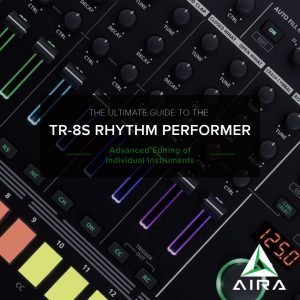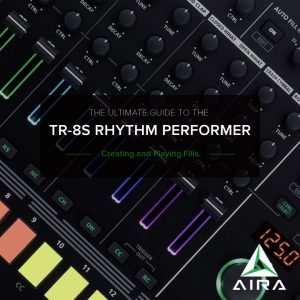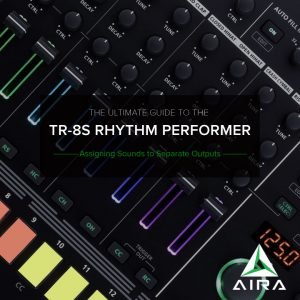Welcome to the ultimate guide to the TR-6S – settings. Here we’ll give an overview of each setting and how you can customise the TR-6S to work for your specific needs. If you haven’t already, I recommend reading the first 3 sections of this guide.
Part 1: https://rolandcorp.com.au/blog/tr-6s-ultimate-guide-basics
Part 2: https://rolandcorp.com.au/blog/tr-6s-ultimate-guide-effects
Part 3: https://rolandcorp.com.au/blog/tr-6s-ultimate-guide-advanced-patterns
All the settings are located in the UTILITY menu. This guide will be broken into the sub-sections of the TR-6S settings, which you can skip through by holding SHIFT while scrolling through the UTILITY menu.
Table of Contents
General
- LCD contrast and brightness are great for performing in a club, or jamming by yourself in the dark at night (guilty!).
- KnobMode determines what happens to a parameter when a knob is turned.
DIRECT means that as soon as you change a parameter, the setting will jump to where the white line on the corresponding knob is. This can sometimes result in harsh parameter changes, so experiment to find what works best for you.
CATCH means that when the white line on the knob moves to the current setting for the selected instrument, it will CATCH the setting and begin to change it from that position, giving a gentler transition of the parameter. - Manual Mode – with this setting OFF: The sound is heard according to the
settings of the kit.
Set to LVL, the sound is heard at the volume of
the level fader positions. Otherwise, the
settings of the kit are used. - Ptn Lock we discussed in a previous step.
- Start Ptn allows you to select the pattern that is presented on startup of the TR-6S.
- Start Kit is the default KIT for a new PATTERN.
- TempoSrc is the source of the TEMPO.
With TempoSrc set to PTN, each time you change pattern, the TEMPO set for that pattern will determine the master TEMPO.
With TempoSrc set to SYSTEM, the master TEMPO will remain the same when you change pattern. Great for playing live when you want every pattern to stay in sync. - Shuffle is the same concept as TempoSrc above.
PTN means that the SHUFFLE amount is determined by the PATTERN.
SYSTEM means that the SHUFFLE for each pattern is determined by a master source. Again, useful to keep consistency when changing patterns. - KitSel determines the source of the KIT when changing patterns.
With KitSel set to PTN, the kit set for the pattern will take precedence.
With KitSel set to KIT, whatever KIT you choose will remain constant when changing patterns. - M.Trig determines how the FILL IN TRIG button behaves.
LATCH means that when you press the FILL IN TRIG button, it will stay active until the end of the bar.
If M.Trig is set to MOMENTRY, then the FILL IN TRIG button is only active while you press or hold it. - WeakBeat determines how the step sequencer behaves when entering notes on different steps.
With WeakBeat set to wSHIFT, you must hold SHIFT and press a step to enter a weak note.
WeakBeat set to PAD allows you to press a pad once for a loud step, and press twice for a weak step. - Auto Save. Any gamers out there? Auto Save OFF means that patterns will not automatically save. Auto Save ON means that patterns will automatically save, which can be handy if you’re forgetful. The Auto Save happens when the device is powered off.
Be careful with this feature! As handy as it is, if you have some nice pre-made patterns that you enjoy jamming on, and you have Auto Save turned ON, then you will lose them when you power down! - USB Volume Specifies whether or not the VOLUME knob adjusts the volume of the TR-6S when plsying audio through the USB output.
Reload
The RELOAD section of this menu allows you to revert to the saved state of the selected Pattern, Kit, or Inst.
Sample
The SAMPLE section allows us to import, delete, change the category name, or optimize our samples on the TR-6S and the SD card. More on this in another guide 🙂
LED
- In this section, you can change the Brightness and Glow of the LEDs.
- Slider determines where the sliders draw their colours from – either the KIT or the SYSTEM colours.
- Demo means that after X mins of inactivity on the TR-6S, the lights will dance for us. X = number of minutes, as shown on the display.
Sync/tempo
- Tempo Sync allows us to determine the source of the tempo on the TR-6S. Choose between:
AUTO, some devices have the capability to be set to “master tempo.” While only using the TR-6S, it is, of course, the master tempo.
MIDI from an incoming MIDI source.
USB from a USB source.
INT the internal clock.I suggest leaving it on AUTO unless you’re getting technical and connecting the TR-6S with external MIDI gear or a DAW such as Ableton Live. If that’s something you’re interested in learning more about, check out the guide on the TR-6S with Ableton below.
https://rolandcorp.com.au/blog/tr-6s-ableton-live-guide - Sync Out determines whether the TR-6S sends its MIDI data out.
- RxStartStop determines whether the TR-6S starts or stops with external gear or a connected DAW.
If RxStartStop is set to ON, the TR-6S will start and stop with connected external gear.
OFF means that it won’t.
MIDI
The MIDI section has various settings for MIDI control data, such as MIDI channels and individual instrument notes. If you’re interested in this, I can assume you probably already know what’s going on. If not, I will discuss it in another guide.
Sound
- Local SW Specifies how the controller section and the sequencer section are connected to the internal sound engine.
OFF: The controller section and sequencer section are internally disconnected from the internal sound engine. Sound is produced only in response to performance data from an external MIDI device.
ON: The controller section and sequencer section are internally connected with the internal sound engine. Normally you will leave this setting selected.
SURFACE: The controller section, sequencer section, and external MIDI device are disconnected from the internal sound engine. Choose this setting if you want operations on the TR-6S to only control an external device
Utility
- Initialise patterns and kits, restoring them to a blank slate.
- Exchange patterns and kits from other locations on the TR-6S.
- Export patterns and kits to the SD card.
- Import patterns and kits from the SD card to the TR-6S.
- Backup data to the SD card.
- Restore data from the SD card.
- Factory reset to restore the TR-6S to version 1.00 as it came out of the box.
SD Card
- Format the SD card and
Information
- Version shows us the firmware version currently installed in the TR-6S
Final words
So there you have it, a detailed guide to inner workings of the TR-6S settings.
In another guide, we will discuss how to import and export your own samples (yes, you can! – and it even supports stereo samples!).
I’ve also written a separate guide on how to run the TR-6S with Ableton Live, and some different routing options for integration into the software.
Check out the Ableton Live guide here: https://rolandcorp.com.au/blog/tr-6s-ableton-live-guide
See more of the TR-6S here: https://www.roland.com/au/products/tr-6s/
If you’re after any additional information on the TR-6S, check out the knowledge base from Roland:
https://www.roland.com/au/support/by_product/tr-6s/owners_manuals/
Now, go make some beats!!
Looking for more information? Check out the video manual below
Contributed by Joel Tullemans
www.sirpants.com








